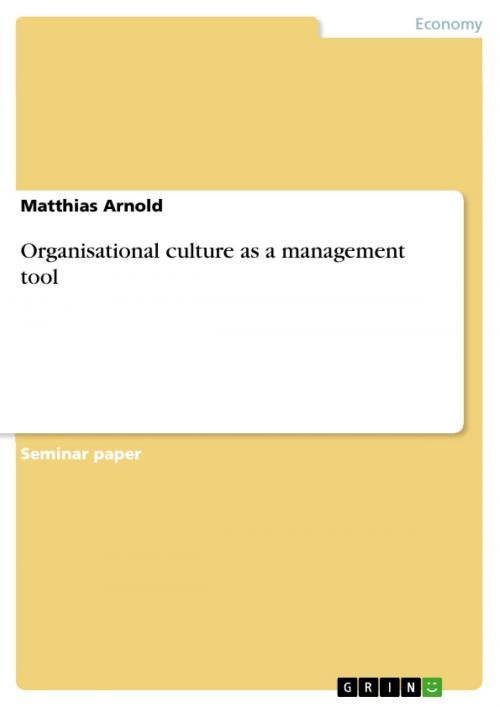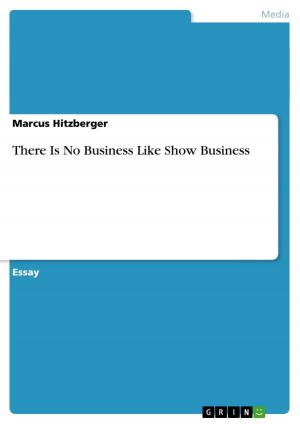Organisational culture as a management tool
Business & Finance, Human Resources & Personnel Management| Author: | Matthias Arnold | ISBN: | 9783638505918 |
| Publisher: | GRIN Publishing | Publication: | May 29, 2006 |
| Imprint: | GRIN Publishing | Language: | English |
| Author: | Matthias Arnold |
| ISBN: | 9783638505918 |
| Publisher: | GRIN Publishing |
| Publication: | May 29, 2006 |
| Imprint: | GRIN Publishing |
| Language: | English |
Seminar paper from the year 2005 in the subject Business economics - Personnel and Organisation, grade: 72%, University of Bradford (School Of Management), course: Organisational Behaviour, 15 entries in the bibliography, language: English, abstract: This assignment aims at discussing whether a strong organisational culture which can be used as a tool of management control helps to both motivate staff and improve company performance and should therefore be encouraged. Organisational culture can be defined as 'the basic values, ideologies and assumptions which guide and fashion individual and business behaviour.' (Wilson and Rosenfeld 1990, p.229). Following Schein, organisational culture can be subdivided into three levels, representing the visibility to the observer. Most visible are the culture's artefacts or surface manifestations, including organisational structure, processes, physical environment, technology and products, employees clothing, manners of address as well as language and company myths. These and other artefacts can be discovered while interacting with the organisation as an employee, customer or other stakeholder. The second level are espoused beliefs and values. The companies set of values normally establishes over a long period emerging from the founders and managements own mindset. These values are (or better should be) adopted by all employees as a part of their own values and beliefs and are also manifested as stated company values. The third and most in-depth level of organisational culture are the underlying basic assumptions. They evolve when beliefs and values become treated as reality, though they are never visible to an observer and can be described as the company's own culture (Schein 2004). An important factor, when looking at organisational culture is the similarity or differences of the management's and the employee's view of corporate culture. A high match of organizational culture levels results in a strong organisational culture whereas differences in both groups' mindsets lead towards a weak culture. Important thereby is not only a match of the culture's manifestations, which only leads to a superficial strong culture, much more significant is sharing of the same values and underlying assumptions (Hartog and Verburg 2004). In a strong organisational culture, common thinking and views between employers and employees may eventually result in a better working atmosphere, an alignment of the workforce and ultimately in better performance (Deal and Kennedy 2000). Weak corporate cultures on the other hand are marked by less shared values, beliefs and assumptions and are less stringent in its thinking but are therefore also more open to changes and fluctuations. [...]
Seminar paper from the year 2005 in the subject Business economics - Personnel and Organisation, grade: 72%, University of Bradford (School Of Management), course: Organisational Behaviour, 15 entries in the bibliography, language: English, abstract: This assignment aims at discussing whether a strong organisational culture which can be used as a tool of management control helps to both motivate staff and improve company performance and should therefore be encouraged. Organisational culture can be defined as 'the basic values, ideologies and assumptions which guide and fashion individual and business behaviour.' (Wilson and Rosenfeld 1990, p.229). Following Schein, organisational culture can be subdivided into three levels, representing the visibility to the observer. Most visible are the culture's artefacts or surface manifestations, including organisational structure, processes, physical environment, technology and products, employees clothing, manners of address as well as language and company myths. These and other artefacts can be discovered while interacting with the organisation as an employee, customer or other stakeholder. The second level are espoused beliefs and values. The companies set of values normally establishes over a long period emerging from the founders and managements own mindset. These values are (or better should be) adopted by all employees as a part of their own values and beliefs and are also manifested as stated company values. The third and most in-depth level of organisational culture are the underlying basic assumptions. They evolve when beliefs and values become treated as reality, though they are never visible to an observer and can be described as the company's own culture (Schein 2004). An important factor, when looking at organisational culture is the similarity or differences of the management's and the employee's view of corporate culture. A high match of organizational culture levels results in a strong organisational culture whereas differences in both groups' mindsets lead towards a weak culture. Important thereby is not only a match of the culture's manifestations, which only leads to a superficial strong culture, much more significant is sharing of the same values and underlying assumptions (Hartog and Verburg 2004). In a strong organisational culture, common thinking and views between employers and employees may eventually result in a better working atmosphere, an alignment of the workforce and ultimately in better performance (Deal and Kennedy 2000). Weak corporate cultures on the other hand are marked by less shared values, beliefs and assumptions and are less stringent in its thinking but are therefore also more open to changes and fluctuations. [...]















